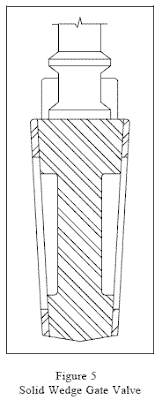GATE VALVE:
Introduction
Gate valves are used in most of chemical process industries,
predominantly in Petroleum industries, because of the attention that it has
gained as a good flow isolation valve with very little or negligible leakage.
Nearly 70% of the valves in petroleum industries are gate valves. They are
suitable for services which require ON/OFF application. Throttling is not
preferred with this valve type.
Construction /
Working:
Rising stem
- The
stem rises/lowers with opening/closing the valve.
- The
stem in closed position is not in contact with the process fluid, hence
corrosion issues are NIL in this case.
- Requires
more space relatively.
- All
fluids are compatible, usually recommended for high temperature and
corrosive fluid application, where its counterpart, non-rising stems is
not applicable.
- Usually
made of cast or forged steel.
Non-rising stem:
·
Stem in this case is static.
·
Screw threads of the stem are exposed to process
fluid so stem damage/contamination (fouling, scaling) is an issue.
·
Requires less space.
·
Used only when the process fluid is a clear
liquid.
·
Usually made of bronze, cast iron, or brass.
GATE / DISC type:
Wedge type
Solid wedge:
- Does
not allow for expansion or contraction of valve body and stem material with large change in
temperature.
- Not
used of high temperature application.
- Can
handle any type of fluid.
- Available in following MOC: bronze, cast iron, carbon steel (CS) etc.
Split gate
- It
allows for expansion and contraction.
- Disc
has better fit in valve seat over wide range of pressure and temperature.
- Appropriate
to handle non-condensing gases and liquids.
Flexible gate:
- For
very high temperature processes, it gives very tight seal on expansion and
contraction on the valve seat over wide range of pressure and temperature.
- Usually
applicable for steam application.
Advantages of Gate valve:
- Lowest
pressure drop across valve when fully opened
- High
Cv (flow coefficient)
- Low
fluid resistance (no obstruction to flow)
- Bubble
tight shut off / Negligible leakage
- High
capacity.
- Multiple
liquids allowed (clean, oil, gas, steam, slurry, corrosive, erosive etc.)
- Good
sealing performance when fully opened.
- Can be
operated manually even for larger pipes.
- Applicable
for wide temperature range and varied line sizes.
- Relatively
low cost valve.
Disadvantages of Gate valve:
- Not
suitable for high pressure applications, since gate acts as a diaphragm
and can bend or burst under high pressures.
- Should
be only used for ON/OFF purpose. Throttling causes vibration and loud
noise.
- Valve
disc and seat undergoes a lot of wear & tear, making it necessary to
replace them more often.
- Possibility
of foreign material blocking the gate from sealing.
- Maintenance
is difficult
- More
space is required
- Long
time to open or close valve.






This comment has been removed by a blog administrator.
ReplyDeleteThank you for reading and sharing.
ReplyDelete#nilesh chouhdary ncl
ReplyDeletebro add transport topic from gery leel book navir stoke
raj p. mehta.. gud work boy.. GOD bless u
ReplyDeleteThis sure informative, I learned a lot about valves, I really appreciate. Thanks.
ReplyDeleteVery Informative!
ReplyDelete